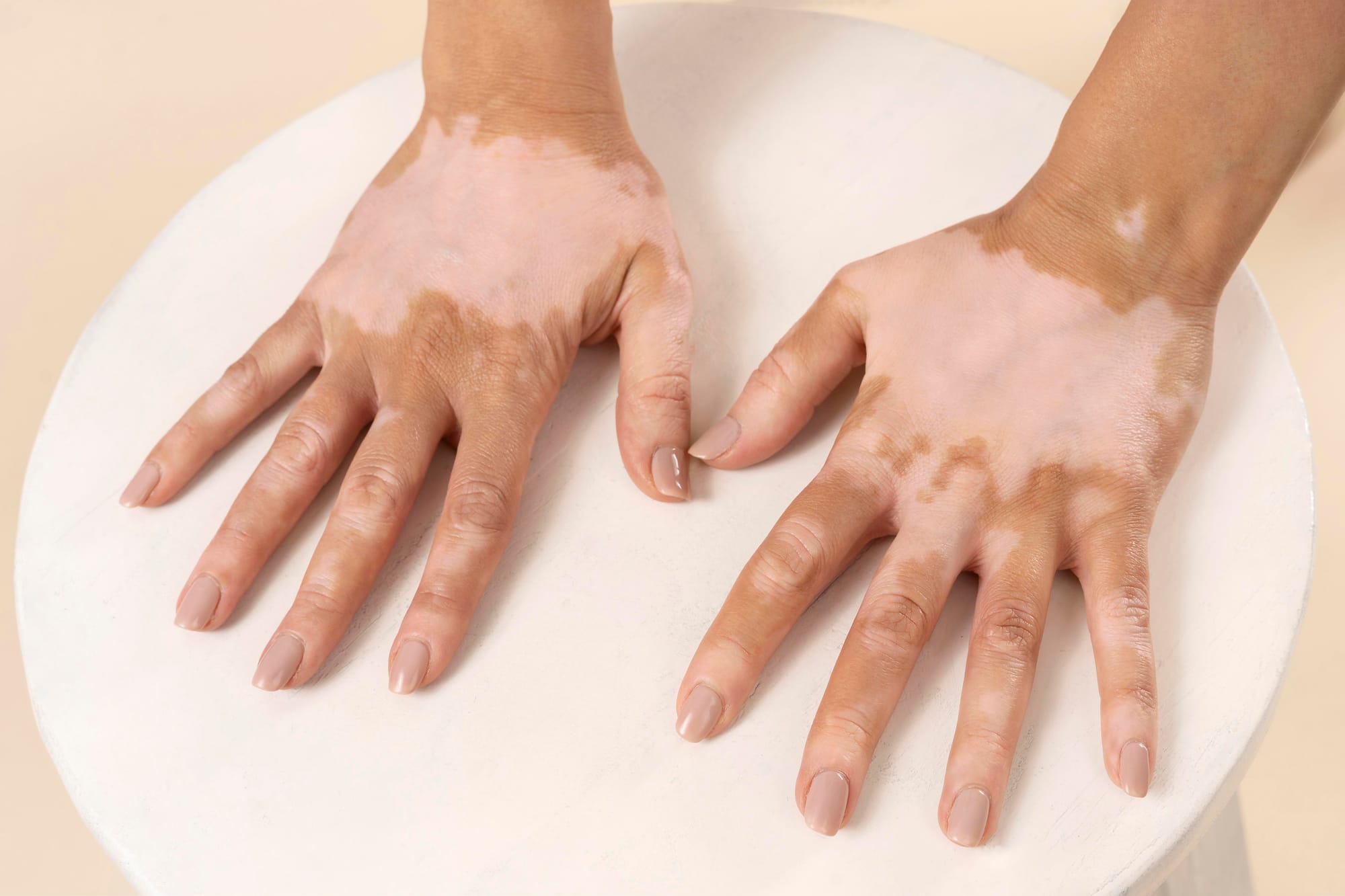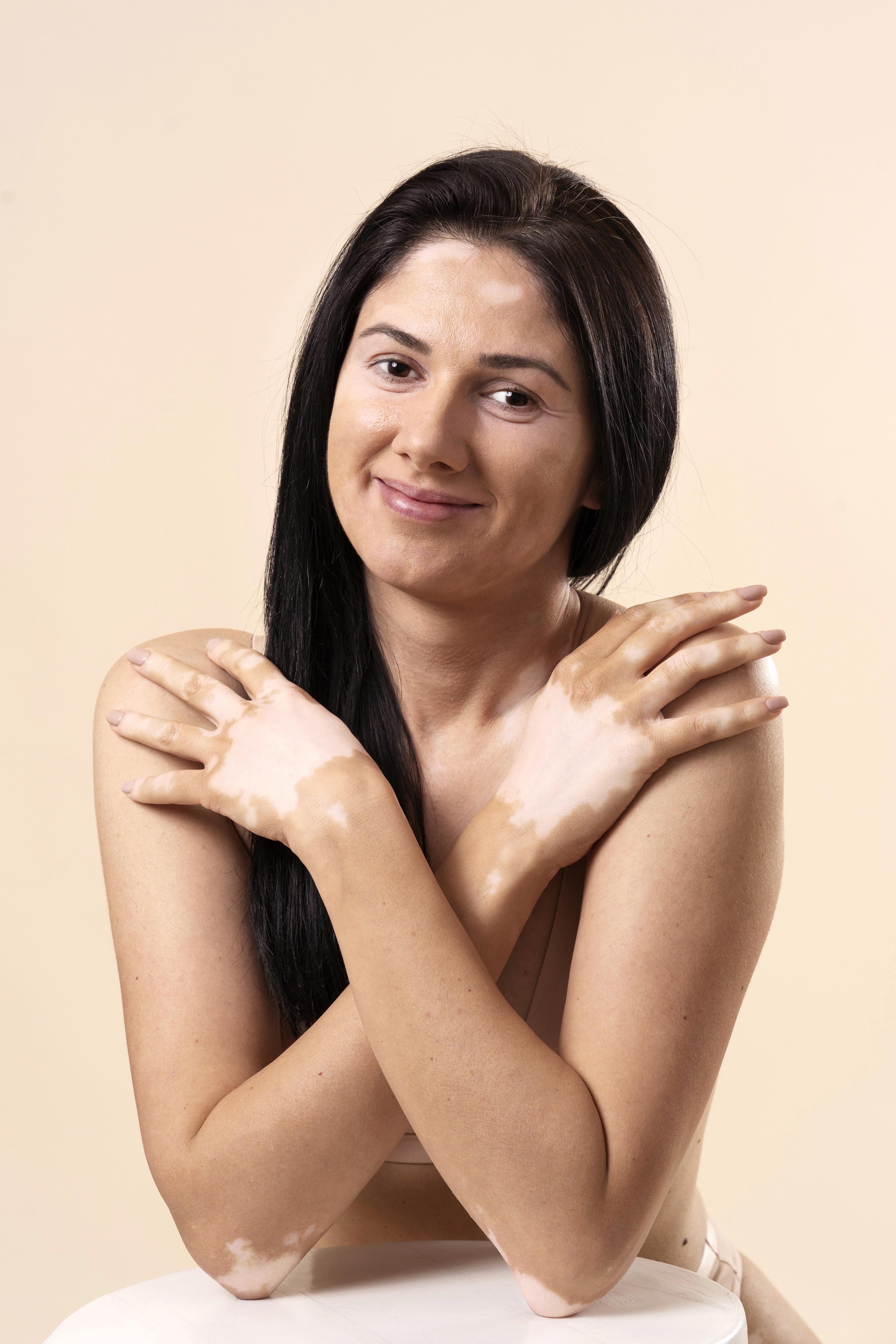Vitiligo: Causes, Symptoms, and Treatment Options

Author: Dr Nnenna Chiloli, MBBS, MPH
Reviewed by Dr Azuka Chinweokwu Ezeike, MBBS, FWACS, FMCOG, MSc (PH)
Highlights
- Vitiligo is an autoimmune disease in which the body’s immune system mistakenly attacks and destroys its skin pigment cells (melanocytes), resulting in patchy loss of skin pigmentation.
- The exact cause is not known; however, research has shown a combination of immune, genetic, and environmental factors.
- The most common symptoms of vitiligo are white or pale patches on the skin, hair, or both.
- Vitiligo frequently affects the face and other visible areas of the body, like the hands, feet, arms, eyes, and genital areas.
- Vitiligo, though, cannot be cured. However, treatment may stop or slow the discolouration process and restore some colour to your skin.
Introduction
There’s more to vitiligo than just lighter skin patches. It's a condition that often raises questions, evokes emotions, and sometimes instils fear. Living with vitiligo can feel overwhelming at first, but you are not alone.
Vitiligo is neither a contagious ailment nor a reflection of your worth. People living with vitiligo can live happy, self–assured lives if they receive the proper information, support, and care.
What is Vitiligo?
Vitiligo is a long-term skin condition where the skin loses cells (melanocytes) that produce melanin, the pigment that gives skin its dark colour [1][2]. It is an autoimmune disease in which the body’s immune system mistakenly attacks and destroys its skin pigment cells (melanocytes), causing loss of skin colour in patches [3]. Vitiligo is the most common skin colour loss disorder affecting 0.1% to 2% of the population worldwide [4].
The skin on any area of your body may be affected by the illness. It can also affect the hair and mucous membranes, for example, the eyes. Vitiligo can start at any age, in childhood or young adulthood, but it develops before 10 years in about 25% of patients and before 20 years in 50% of patients [5]. It is not contagious but can affect anyone, regardless of age, gender, or ethnicity.
It is difficult to predict how the disease will progress. The condition varies from person to person. While some individuals may have a few little white spots, others may experience larger white spots that spread across a sizable portion of their skin.
Sometimes, the patches stop forming without treatment. However, in most cases, pigment loss continues and eventually involves most of the skin. Spontaneous repigmentation of skin colour may occur in some individuals (10-20%), especially in children, but this tends to be only partial and on areas exposed to sunlight [6].
Vitiligo is often dismissed as a cosmetic problem, but its effects can be psychologically damaging, affecting the quality of life of the affected persons. It can occur alone, but can also coexist with other autoimmune diseases.
What are the symptoms of vitiligo?
The main symptom of vitiligo is a patchy loss of natural skin colour. The patches may show up anywhere on the body and may affect the following;
- Skin, affected area of the skin, develops white patches or appears lighter than the usual skin colour. Patches are usually well demarcated. It may be linear, oval, or round in shape.
- Hair, which turns white in areas affected, including the scalp, eyebrows, eyelashes, beard, and body hair.
- Mouth and nose, the loss of colour can also affect the tissues lining the inside of the mouth and nose (mucous membrane).
People with vitiligo can also develop;
- Swelling in the eyes (uveitis)
- Abnormalities in the ear.
Common areas affected by vitiligo are
- Face
- Hands
- Feet
- Arms
- Legs
- Genital areas
- Lips
- Eyes
Types of vitiligo
There are two main types of vitiligo, namely,
- Segmental vitiligo
- Non-segmental vitiligo
Universal vitiligo is a rare type that affects the whole body.
Segmental vitiligo
This is also known as localised or unilateral. It is characterised by;
- White patches that occur on one side of the body
- Less common, occurring in 5% to 16% of patients with vitiligo
- Usually starts early, with early involvement of the hair follicle
- Occur more commonly in younger children
Non–segmental vitiligo
This is the most prevalent type of vitiligo. Nine out of ten patients with vitiligo have this kind.
It is characterised by;
- White spots that are symmetrical(equal) on both sides of the body
- Progressive
- Can have multiple outbursts
- Late involvement of the hair follicle
- Unpredictable course
What causes vitiligo?
Vitiligo occurs when there’s a lack of a natural substance called melanin, which determines the colour of the skin. The reason why this happens is still not clear; however, some researchers suggest the following;
- Autoimmune conditions- in which the body’s immune system mistakes the melanin-producing cells (melanocytes) of the body for foreign. This makes the immune system fight and destroy the melanocytes by developing antibodies against them.
- Genetic factors, vitiligo appears to be more common in those with a family history of the condition
- Environmental factors such as stress, sunburn, trauma, cuts, or exposure to chemicals can trigger vitiligo or make it worse.
Who can develop vitiligo?
You can be at risk of developing vitiligo if;
- Other members of the family have it
- You have another autoimmune condition like thyroid abnormalities, Rheumatoid arthritis, Type 1 Diabetes, Psoriasis, etc
- You have certain types of cancer, like melanoma( cancer of the skin), Lymphoma ( cancer of the lymphatic system), etc
How is vitiligo diagnosed?
Diagnosis of vitiligo is based on good history taking and examination of clinical symptoms. Other investigations may include;
- Microscopic analysis reveals the absence of melanocytes in the affected area of the skin.
- Use of an ultraviolet (UV) lamp (Wood’s lamp) to look at the skin. The skin is seen better under UV light. This helps to distinguish vitiligo from other skin conditions.
How is vitiligo treated?
The goals of treatment of vitiligo are to;
- Restore lost skin colour
- Stop the patches and spots from getting bigger
- Prevent new spots from appearing
There’s no one best treatment for vitiligo; however, some important factors play a role in the treatment options.
These include:
- Age
- Type of vitiligo
- Rate of pigment loss
- The overall health of the affected person
Patients with lighter skin, for instance, might not require intervention. Rather, careful sun protection might be the best course of action to prevent the normal skin around the lesions from getting more tanned.
Different treatment options include;
- Medications
- Phototherapy
- Laser therapy
- Surgery
Medications can be used to control inflammation and suppress the overactive immune system. They include the following;
- Topical drugs, e.g, corticosteroid creams, are applied directly to the skin. This may restore the colour of the skin when vitiligo first manifests.
- Oral steroids can slow or stop rapidly progressing vitiligo.
- Calcineurin inhibitors such as tacrolimus, which suppress the overactive immune system
Phototherapy (light therapy)This treatment involves whole-body exposure to UV light. Phototherapy increases melanin production and melanocyte multiplication. This boosts the skin’s ability to restore its colour in the affected areas. This can also be combined with oral or topical medications.
Laser therapyThe Laser system directs a highly focused beam of ultraviolet light onto targeted areas of skin rather than exposing the whole body to UV light. This minimises UV light exposure to healthy skin.
SurgerySurgery may be necessary where light treatment and medications didn’t work. They include the following;
- Transfer of tiny sections of your healthy, normal skin to areas that have lost colour (skin grafting)
- Transfer of a thin roof of blisters created by suction on normal skin to discoloured skin( blister grafting)
Conclusion
Vitiligo is a chronic autoimmune disorder that causes pigment loss and white patches, significantly affecting the quality of life and self-esteem due to its visible nature. Knowing more about vitiligo and its treatment, communicating your feelings, and seeking understanding and support from family and friends can help you cope.
See a health care professional when you notice any form of patchy discolouration of any part of your skin, hair, or mucous membrane. Early identification and prompt treatment can stop and restore skin colour.
References
- Iwanowski T, Kołkowski K, Nowicki RJ, Sokołowska-Wojdyło M. Etiopathogenesis and emerging methods for treatment of vitiligo. Int J Mol Sci [Internet]. 2023 Jun 5 [cited 2025 Aug 24];24(11):9749. Available from: https://www.ncbi.nlm.nih.gov/pmc/articles/PMC10253679/
- Kubelis-López DE, Zapata-Salazar NA, Said-Fernández SL, Sánchez-Domínguez CN, Salinas-Santander MA, Martínez-Rodríguez HG, et al. Updates and new medical treatments for vitiligo (Review). Exp Ther Med [Internet]. 2021 Aug [cited 2025 Aug 25];22(2):797. Available from: https://www.ncbi.nlm.nih.gov/pmc/articles/PMC8170669/
- Frisoli ML, Essien K, Harris JE. Vitiligo: mechanisms of pathogenesis and treatment. Annu Rev Immunol [Internet]. 2020 Apr 26 [cited 2025 Aug 25];38(1):621–48. Available from: https://www.annualreviews.org/doi/10.1146/annurev-immunol-100919-023531
- Bergqvist C, Ezzedine K. Vitiligo: A focus on pathogenesis and its therapeutic implications. The Journal of Dermatology [Internet]. 2021 Mar [cited 2025 Aug 18];48(3):252–70. Available from: https://onlinelibrary.wiley.com/doi/10.1111/1346-8138.15743
- Mahajan VK, Verma YR, Mehta KS, Chauhan PS, Sharma R, Sharma A, et al. Adults with a more extensive body involvement, moderate to extremely severe vitiligo and a prolonged clinical course have an early onset in childhood in addition to other prognostic factors as compared to individuals with later‐onset vitiligo. Aust J Dermatology [Internet]. 2021 Feb [cited 2025 Aug 25];62(1). Available from: https://onlinelibrary.wiley.com/doi/10.1111/ajd.13417
- Yaghoobi R, Omidian M, Bagherani N. Vitiligo: A review of the published work. The Journal of Dermatology [Internet]. 2011 May [cited 2025 Aug 18];38(5):419–31. Available from: https://onlinelibrary.wiley.com/doi/10.1111/j.1346-8138.2010.01139.x
Disclaimer:
The information provided on this website is for general educational and informational purposes only. It is not intended to replace professional medical advice, diagnosis, or treatment. Always seek the advice of your physician or other qualified health provider with any questions you may have regarding a medical condition.
Published August 25, 2025
